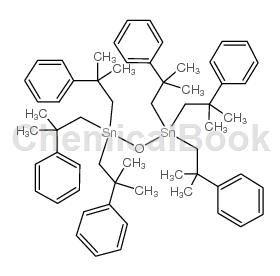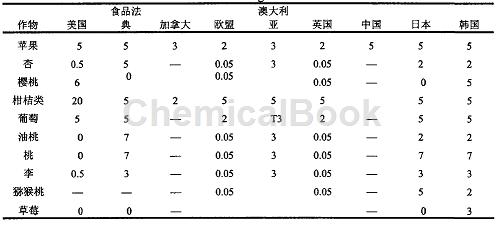Background and overview[1][2]
A thermosensitive organotin acaricide that inhibits nervous tissue. The trade names of fenbutyl tin include Torque, Torque, Vendex, Osdaran, etc. It was developed and put into production in 1974 by Shell International Chemical Co. Ltd. of the United Kingdom. The original drug is a colorless crystalline powder with an active ingredient content of 97%, a melting point of 138-139°C, and a vapor pressure of 6.7×10-6Pa at 25°C. Hardly soluble in water, soluble in acetone, easily soluble in benzene, methylene chloride and other organic solvents. It is stable to light and heat, and can be hydrolyzed when exposed to water. The hydrolyzate can be slowly converted into the original compound at room temperature (quickly at 98°C). It is relatively stable when stored under appropriate conditions.
Highly toxic to fish and other aquatic organisms, lowly toxic to birds and bees, and safe to predatory mites, insect-eating ladybirds, lacewings, etc. It has high acaricidal activity and mainly acts as a contact kill. It is highly lethal to young mites and adult and nymphal mites, but not very lethal to mite eggs. It has no interaction with harmful mites that are resistant to organophosphorus and organochlorine insecticides. Drug resistance. It is a temperature-sensitive acaricide. When the temperature is above 22°C, the efficacy increases, when the temperature is below 22°C, the activity decreases. When the temperature is below 15°C, the efficacy is poor, so it should not be used in winter. After application, the efficacy of the drug is slow, and the activity begins to increase after 3 days, reaching the peak in 14 days, and the residual effect period is long, up to 2 to 5 months.
Structure

Apply[1-2]
Phenylbutanol can be processed into wettable powders, suspensions and other dosage forms for use. It can be used on fruit trees, tea trees, flowers and other crops to prevent and control citrus spider mites, citrus rust mites, apple spider mites, tea orange gall mites, tea shortbeard mites, chrysanthemum spider mites, rose spider mites, etc. Used for citrus, grapes and other fruit trees and ornamental plants to prevent and control plant-based mites in various active stages. The oral LD50 in rats is 2630 mg/kg. Relatively non-toxic to bees and toxic to fish. Organotin acaricides. It has good control effect on plant spider mites, gall mites, and rust mites, and has good activity on both juvenile and adult mites. It mainly has a contact killing effect, has a long residual effect, has no systemic effect, and has a poor effect on eggs.
It has no interaction with organophosphorus-resistant pest mites and is safe for crops and natural enemies. Used when the temperature is high, the medicinal effect will be good. It is used to control spider mites on citrus, apples, pears, grapes, tea trees, beans, eggplants, melons, tomatoes and other vegetables. It can also be used to control ornamental plant-eating mites. For example, to control citrus red spider mites, use 2000-2500 times liquid spray of 50% wettable powder, and 2000 times liquid spray for rust mites. When spider mites and rust mites coexist, both spider mites and rust mites can be treated.
To control hawthorn and apple spider mites, use 50% wettable powder spray with 1000-1500 times liquid. For spider mites on eggplants, beans and other vegetables, use 1500-2500 times liquid spray. For tea tree shortbeard mites and orange gall mites, use 1000-1500 times liquid spray. 1500x liquid spray. If there is a study, the efficacy of commonly used agents for controlling citrus (Jinggang pomelo) red spider mites currently on the market will be compared, and their control effectiveness and safety will be objectively and scientifically evaluated. Phentermine tin suspension has good control effect on citrus (Jinggang Miyou) spider mites and is safe for the growth of citrus (Jinggang Miyou). When using it, considering the control effect and cost, it is recommended to dilute the solution 800~1000 times (that is, the concentration of the active ingredient is 250~200mg/kg), and apply the pesticide to control citrus spider mites during the peak period.
Use 1500L of pesticide solution every 1hm2 and spray evenly until it starts dripping on both sides of the leaves. Pay attention to the back of the leaves and both sides of the veins. When red spider mites occur on citrus trees, high-concentration spraying should be used. Since citrus (Jinggang Miyou) red spider mites are very easy to develop resistance, and the acquired resistance may be inherited, chemical agents must be used in a reasonable rotation, and the same agent cannot be used continuously for a long time to prevent or delay citrus red spider mites. Spiders develop resistance to antibiotics. At the same time, try to use selective treatment methods to protect and make good use of the natural enemies of citrus (Jinggang Miyou) spider mites.
Limited Standard[3]
Acaricides have effectively reduced the economic losses caused by pests and improved the yield and quality of crops. However, due to the emergence of endless types of acaricides in recent years, non-phytogenetic acaricides have varying degrees of toxicity, and producers Irregular operation has also brought hidden dangers to human health and environmental safety, and the issue of pesticide residues has attracted increasing attention. More and more countries and international organizations have strengthened the monitoring of acaricide residues and formulated strict regulations.��’s limit standard. Japan’s positive list has limited regulations on fenbutyl tin in apples, apricots, cherries, citrus, grapes, peaches and other fruits.

Degradation[3]
The study of styrenebutin is based on the study of its analytical methods. Phentermine is an organotin acaricide. Gas chromatography is used to study the residual amount of styrenebutin, which requires a derivatization reaction. Currently, relevant There are relatively few studies on the environmental behavior of phenbutyltin. Gas chromatography was used to study the degradation pattern of fenbutyltin in manganese and soil from Zhejiang, Hunan and Guangxi. Its degradation half-life was days and days respectively. Due to the influence of environmental factors such as climate, geology and temperature, the degradation rules of the same pesticide will be different in different regions.
Notes[4]
① Medication concentration. Use 2000-3000 times of 50% styrene-butyl tin wettable powder to control citrus spider mites and rust ticks, and use 1000-2000 times of solution to control apple spider mites and mountain plant spider mites. The effect is good; ② Application time. After this drug is sprayed, its activity starts slowly, so it should be sprayed when the density of the mite population is low (that is, 2 to 3 mites per leaf). Because it is a temperature-sensitive acaricide, it is not effective when the temperature is below 15°C, so the application should be carried out in weather above 20°C. ③ Spray should be even. The main killing effect of this drug is contact killing, so the liquid should be sprayed on the top and bottom of the fruit tree and the front and back of the leaves. In addition, phenbutyl tin can be mixed with most pesticides and fungicides, but cannot be mixed with alkaline pesticides such as Bordeaux mixture.
Preparation
First, the Grignard reagent is prepared by reacting 1-chloro-2-methyl-2-phenylpropane with magnesium, and then reacting with tin tetroxide to generate tris(2-methyl-2-phenylpropyl) chloride Chemical tin, and then generate acaricidal tin under the action of sodium hydroxide. Raw material consumption quota: methallyl chloride 1700kg/t, benzene 1800kg/t, metal magnesium 300kg/t, metal tin 300kg/t, tetrahydrofuran 400kg/t, xylene 300kg/t. 2. The Grignard reagent prepared by the reaction of 2-chloromethyl-2-phenylpropane and magnesium reacts with tin tetrachloride to generate tris(2-methyl-2-phenylpropyl)tin chloride, which is then dissolved in NaOH Under the action of the solvent, it undergoes desolvation and condensation to form styrene-butyltin.
Main reference materials
[1] Encyclopedia of Chinese Agriculture·Pesticides Volume
[2] Briefing on the experimental results of 20% phenbutyltin suspension for controlling citrus spider mites
[3] Residue dynamics of fenbutyltin and spirodibenzofen-pyridaben in citrus and soil
[4] Research on the application technology of fenbutyltin to control citrus blight and apple dragonfly

 微信扫一扫打赏
微信扫一扫打赏

